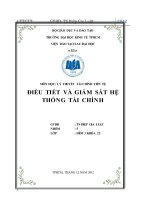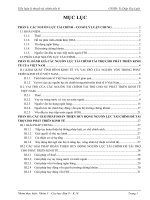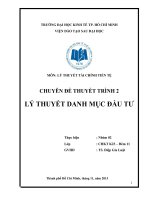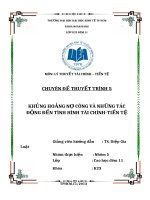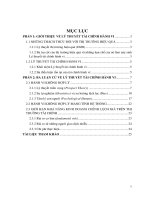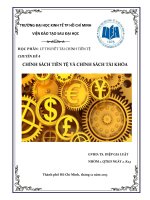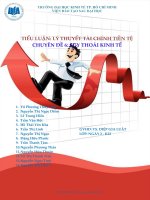tiểu luận lý thuyết tài chính diary of principles of finance
Bạn đang xem bản rút gọn của tài liệu. Xem và tải ngay bản đầy đủ của tài liệu tại đây (228.47 KB, 13 trang )
Introduction
Finance plays an important role in the economy. Being an economic students,
I have to research and learn about the finance to widen my knowledge and
apply theories and concepts to solve practical problems in my work and life
as well. My first financial subject is Principles of Finance, which provides a
fundamental knowledge and concepts about finance. In addition, a learning
diary of my lecturer - Mrs. Mai Linh is the best idea and an effective method
for me to review what I have learned, reflect my further research and
motivate myself as well. There are lots of useful things that I have learned
such as financial markets, financial institutions, financial instruments, how
the money has changed as time goes by, how I could make decisions on
investment and others concepts. However, one most interesting thing that
attracts me through this subject is the financial crisis. That sounds strange
because most my friends are interested in the positive and bright sides of
1
finance. But for me, crisis means opportunity and it’s also right in finance. In
fact, my family had a financial crisis when I was in grade 3. My father lost
his job because of the crisis of export - import company in 2009 and we fell
on hard times. When I grow up and hear about the story of financial crisis
2007-2008 that gives me many thoughts. So I decide to research deeply to
find the reasons why it has a big effect to world’s economy including
Vietnam. Many people say that the 10-year cycle of a globally financial crisis
is true when they look back in history. So they believe that it may have one in
this year or next year. Furthermore, on these days, there was a report on the
VTV1 news: “Vietnamese shares suffered one of their sharpest drops ever on
Thursday after Wall Street’s worst losses in eight months triggered a surge of
global selling that hit markets in Asia”. I wonder if the financial crisis will
come back and will be more serious than before. What would happen? Will
Vietnam also be affected? What about banking system? What would happen
if people try to withdraw their deposits at the same time when they hear this
2
news? What could I do to manage risks? Are there any solutions? There are a
number of questions about this issue that come to my mind. As a result, I
decide to find answers for these questions and do further research about
financial crisis in this diary.
I- Diary of Principles of Finance
1. Introduction to Corporate Finance
On the first day of course, my lecturer told my class to learn more at home
about Corporate Finance in order to know about how many types of firms,
the ownership and the control of corporations and the financial decisions of
firms as well. It was not so new to us about four major types of firms that we
have learned in Macroeconomics subject: sole proprietorships, partnerships,
limited liability companies and corporations. But this was a chance for us to
learn deeper in financial aspect.
One special thing I realized that the 80/20 rule was applied in these types of
firms in U.S. Statistics indicate that only 19% of corporations are responsible
3
for 84% of U.S. revenue. In contrast, 81% others including sole
proprietorships, partnerships and limited liability companies accounted for
only 16% revenue of U.S. So why few people choose corporation because of
double taxation of corporation profits. The corporation pays federal and state
taxes on its profits. When dividends are paid to shareholders, they are treated
as income and taxed again. Furthermore, forming a corporation requires
investing more money and time than another business entity. They need to
file the appropriate registration, fulfill capital requirements, and formally list
the corporate directors among other things. But few corporations accounts for
the majority of U.S revenue. Because one of the advantages of corporation is
the ease of funding. Corporations can transfer ownership by buying or selling
its shares. Public corporations have a much easier time than private
companies to exchange shares, but regardless, corporation offers its members
the easiest means for transferring ownership. Also, a corporation has no limit
4
to its life. If owners die or want to dissolve their shares, they simply sell or
transfer their ownership to someone else.
This is the first time that I know about the differences between ownership and
the control of a corporation. I had always thought that the owner was also the
operator who directly run the company. However, in a corporation, direct
control and ownership often separate. Rather than the owners, the board of
directors and Chief Executive Officer possess direct control of the
corporation. According to organizational chart of a typical corporation, the
board of directors, representing the stockholders, controls the corporation and
hires the Chief Executive Officer who is then responsible for running the
corporation. The Chief Financial Officer oversees the financial operations of
the firm, with the Controller managing both tax and accounting functions and
the Treasurer who is responsible for capital budgeting, risk management and
credit management activities.
5
As I work in Business Ideas Team - an Foreign Trade University ’s club that
focus on entrepreneurship and social innovation so I usually discuss about a
popular question relating to types of business: What is the best form of
business for startup?. Through this lesson, I can evaluate the pros and cons of
each business structure. The answer is that it depends. Sole proprietorship is
best for business owners with no or few employees, such as consultants, who
can handle legal risks with adequate insurance or do not have assets to
protect. Meanwhile, partnership - a common structure in the real estate
industry is best for businesses that will be owned and operated by several
individuals. Corporation is best for the businesses that need liability
protection and flexibility to grow into a large organization. It’s a popular
structure for manufacturers and restaurants. On the other hand, the limited
liability company (LLC) is popular among businesses that are just starting out
and not totally sure how much they will grow in the first year or so. In
conclusion, it depends on the objectives, resources, industry entry and other
6
factors of startup but the owners have to identify and evaluate well the
company’s situation.
2. Financial System
As I learn about financial system, it includes six parts: money, financial
instruments, financial markets, financial institutions, regulatory agencies and
central bank. These concepts help me make better financial decisions. Due to
the flow of funds through financial system, I can understand how the funds
are transferred in direct and indirect way in economy. If I want to further
education such as study abroad or buy a house or start a new business, I could
know where I get the funds to do it, how to make a loan and minimize the
risk. This lecture also provides a conceptual framework for understanding
how financial works and how it changes over the time. Thanks to this lesson,
I know an more effective way to handle the transfer of resources over time
that takes place through the financial system. For example, I am saving for
7
my own retirement by saving money in a bank account. A more effective way
for me to save for retirement through an insurance company or mutual fund
retirement account whose sole function is to provide retirement income.
In financial markets lesson, I understand its definition, role and structure in
financial system. They not only contribute to increase the production and
efficiency in the overall economy and provide the liquidity but also improve
the wealth of individual participants by providing investment returns to
lenders and profit, opportunities for borrowers. In addition, everyday we are
showered with newspaper, television, online magazine and online computer
reports of financial market indicators. These include interest rates, exchange
rates and indicators of stock market performance. Thanks to this financial
markets rates section, I can read these numbers and understand the meanings.
So that I can make better decisions in investment in the future.
3. Time value of money
8
This is the section that usually gives me a headache with numbers. But it is
very interesting when I finally solve these problems. This lesson provides one
of the most useful tools to evaluate projects, investment and cash flows.
Actually, the tools allow me to compare cash flows that occur at different
point in time. The first tool is a visual method for representing a stream of
cash flows: the timeline. Afterwards, I can establish three important rules for
moving cash flows to different points in time. Three rules of time travel are
comparing and combining values, moving cash flows forward in time and
back in time. By using these rules, I can calculate the present value and future
value of costs and benefits of a general stream of cash flows. By converting
all cash flows to a common point in time, I compare the costs and benefits
and thus assess its net present value (NPV). Through NPV, I could decide to
invest the project or not, or any other financial decisions.
In reality, I have applied this tools to calculate and evaluate my financial plan
of social business projects in my club - Business Ideas Team. It helps me to
9
identify the possibility of projects, the cash inflows, outflows and net present
value.
II - Further research
1. Financial Crisis
Financial crises occur when there is a disruption in the financial system
that causes such a sharp increase in adverse selection and moral hazard
problems in financial markets that the markets are unable to channel funds
efficiently from savers to people who have investment opportunities. As a
result, financial frictions increase sharply and financial markets stop
functioning. Then economic activity will collapse.
One of the World’s Most Devastating Financial Crises is The Great
Depression of 1929 - 1939. This was the worst financial and economic
disaster of the 20th century. Many believe that the Great Depression was
triggered by the Wall Street crash of 1929 and later exacerbated by the poor
10
policy decisions of the U.S. government. The Depression lasted almost 10
years and resulted in massive loss of income, record unemployment rates, and
output loss, especially in industrialized nations. In the United States the
unemployment rate hit almost 25 percent at the peak of the crisis in 1933.
The financial crisis of 2007–2008, also known as the global financial
crisis and the 2008 financial crisis, is considered by many economists to have
been the worst financial crisis since the Great Depression of the 1930s.
Triggered by the collapse of the housing bubble in the U.S., the crisis resulted
in the collapse of Lehman Brothers (one of the biggest investment banks in
the world), brought many key financial institutions and businesses to the
brink of collapse, and required government bailouts of unprecedented
proportions. It took almost a decade for things to return to normal, wiping
away millions of jobs and billions of dollars of income along the way. In
addition, leverage ratios of investment banks increased significantly between
2003 and 2007. Prior to the crisis, financial institutions became highly
11
leveraged, increasing their appetite for risky investments and reducing their
resilience in case of losses. Much of this leverage was achieved using
complex financial instruments such as off-balance sheet securitization and
derivatives, which made it difficult for creditors and regulators to monitor
and try to reduce financial institution risk levels. These instruments also made
it virtually impossible to reorganize financial institutions in bankruptcy, and
contributed to the need for government bailouts.
Source: The financial crisis of 2007-2008 (Wikipedia.com)
12
13
